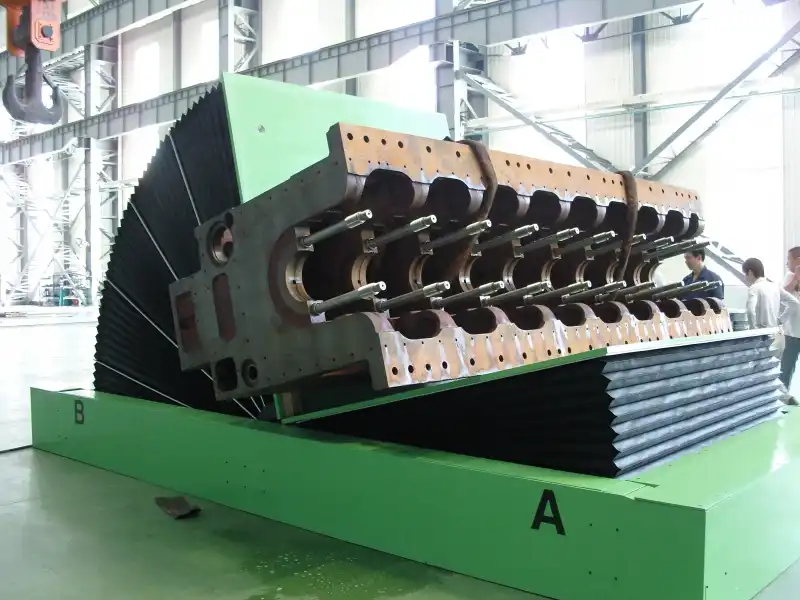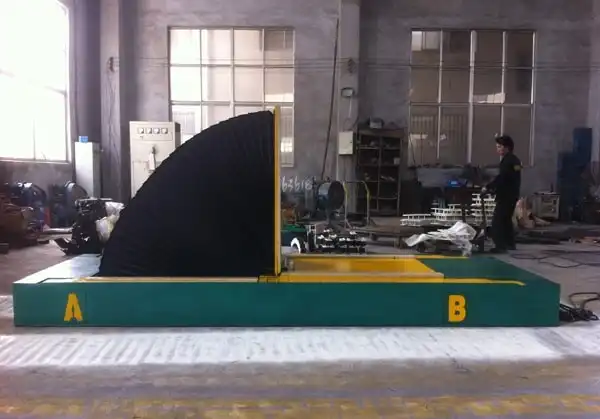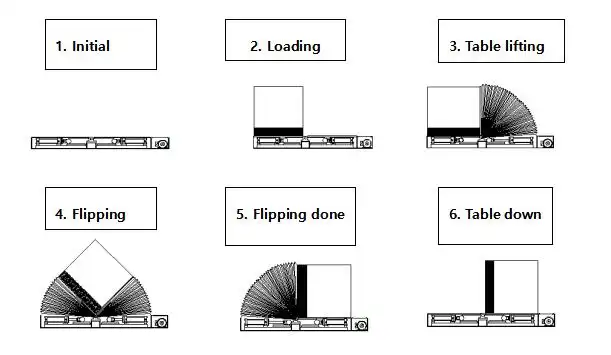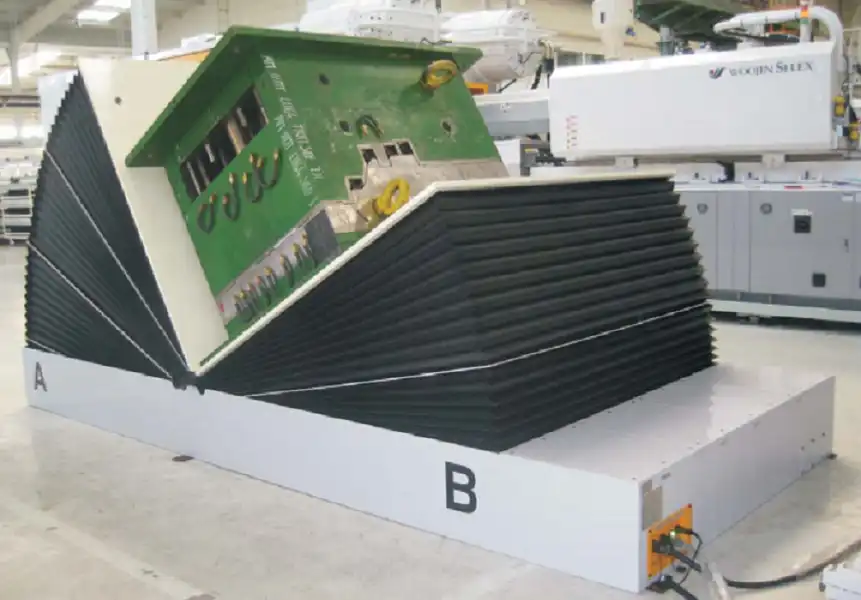Is Your Current Mold Flipping Method Hurting Productivity in American Plants?
I’ve spent my life on factory floors, first as an engineer and now as the founder of SHJLPACK. I’ve seen countless American plants invest millions in state-of-the-art production lines. But then I see them handle their expensive molds using outdated, slow, and dangerous methods. They meticulously track the efficiency of their main equipment but completely ignore the critical process that happens in between: mold flipping. This oversight creates a hidden bottleneck that quietly drains productivity, poses serious safety risks, and eats into profits day after day.
Yes, your current mold flipping method is very likely hurting productivity in your plant. Outdated techniques, such as using overhead cranes with chains or manual prying, introduce significant downtime, create substantial safety hazards, and risk damaging expensive molds. These inefficiencies translate directly into lost production hours, increased operational costs, and a reactive, unpredictable maintenance environment, undermining the overall efficiency goals of modern American manufacturing facilities.

I know the pressure you're under. Men like Javier Morales, a steel mill owner I know in Mexico, are constantly battling rising energy costs, aging equipment, and market fluctuations. Every investment must be justified with a clear return. It's easy to focus on the big machines. But my experience has shown me that true operational excellence is often found by fixing the small, overlooked processes. In this article, I want to walk you through the real costs of inefficient mold flipping and show you how addressing it can be one of the smartest decisions you make for your plant's productivity and safety.
You see it every day. A heavy mold, weighing several tons, is slowly lifted by an overhead crane. Workers stand nearby, guiding it with ropes or their hands as it awkwardly swings and rotates. Or maybe you use a large forklift in a delicate, clumsy ballet. It's a routine operation, one that has been done this way for 15 years. It seems fine because a major accident hasn't happened yet. But the potential for disaster is always there, lurking in the background of this everyday task.
Absolutely. Outdated mold flippers and manual handling methods are a significant and often underestimated safety risk on factory floors. They rely heavily on operator skill and coordination, leaving no room for error. A worn-out chain, a sudden hydraulic leak, or a moment of inattention can lead to catastrophic equipment failure, severe injuries, or fatalities, creating huge financial and human costs for the company.

As a young engineer, I witnessed a near-miss that I’ll never forget. A team was flipping a large stamping die using a crane. One of the chains slipped. The multi-ton die dropped a few inches before catching again, swinging violently. Nobody was hurt, but the shock on the workers' faces was palpable. The entire production area froze. The plant manager later told me that incident alone cost them thousands in inspection costs for the die and the crane, not to mention the lost production time. It was a wake-up call for him, and for me. Traditional methods introduce risks that are simply unacceptable in a modern industrial environment.
The Anatomy of an Unnecessary Risk
Let's break down exactly where the dangers lie. Traditional methods are not just "old-fashioned"; they are fundamentally flawed from a safety engineering perspective. They introduce variables that are difficult or impossible to control.
- Overhead Cranes with Chains/Slings: This is the most common and one of the most hazardous methods. The center of gravity shifts unpredictably as the mold turns. The chains can slip, and the load can swing unexpectedly. Workers are required to be in close proximity to the suspended load to guide it, placing them directly in the danger zone.
- Forklifts: Using a forklift to nudge or lift a mold to flip it is an off-label use of the equipment. Forklifts are designed for lifting, not for providing precise, controlled rotational force. This can lead to the mold tipping over, falling off the forks, or damaging the forklift itself, creating an unstable and dangerous situation.
- Manual Pry Bars and Jacks: For smaller molds, I’ve seen teams use muscle, pry bars, and jacks. This method is slow and carries a high risk of crush injuries, strains, and sprains. A slipped jack or a lost grip can have immediate and painful consequences for the operators involved.
How Modern Systems Engineer Safety In
A dedicated mold flipper, in contrast, is a purpose-built machine designed for one task: to turn heavy objects safely and efficiently. It's not an adaptation; it's a solution. Safety is not an afterthought; it's engineered into the core design.
| Safety Feature | Traditional Method (e.g., Crane) | Modern Mold Flipper | Impact on Operations |
|---|---|---|---|
| Controlled Rotation | Unpredictable; relies on gravity and manual guidance. | Smooth, controlled 90 or 180-degree rotation on a stable platform. | Eliminates swinging loads and unpredictable movements. |
| Load Security | Relies on chains/slings that can slip or be improperly attached. | Mold is placed on a solid table; some models have clamping systems. | The load is secure and stable throughout the entire process. |
| Operator Position | Workers are often required to be in close proximity to the load. | Operated via a remote control or a fixed panel away from the machine. | Keeps personnel out of the immediate danger zone. |
| Built-in Interlocks | None. Relies entirely on operator procedure and attention. | Safety interlocks prevent operation if guards are open or load is off-center. | Prevents accidents caused by human error or improper setup. |
| Emergency Stop | Crane E-stop may be far away; no specific control for the flipping action. | Prominently placed E-stop buttons that halt all motion immediately. | Provides an instant, reliable way to stop the process in an emergency. |
Upgrading is not just about a new piece of equipment. It's about fundamentally changing your process to remove risk. It's about telling your employees that their safety is a non-negotiable priority. For a leader like Javier, who manages a large workforce, this shift from a reactive to a proactive safety culture is a powerful statement and a sound business decision.
How much production time are you losing to slow, manual mold flipping?
Think about the last time you had a mold change. Your production line stopped. The clock started ticking. A team of operators gathered around the press. They spent minutes finding the right chains, carefully hooking them up to the crane, and slowly, cautiously maneuvering the heavy mold out. Then came the flip, a delicate process full of stops and starts. Finally, the new mold was brought in and the process was repeated in reverse. This entire changeover might have taken 45 minutes, maybe even an hour. You accept this as a standard cost of doing business. But what if it wasn't?
You are losing a substantial amount of production time, likely 30 to 50 minutes per mold change. A manual or crane-based mold flip is a slow, labor-intensive process that directly halts production. A modern, dedicated mold flipper can perform the same task in less than 5 minutes with a single operator. This reclaimed time goes directly back into production, significantly boosting your overall equipment effectiveness (OEE) and plant capacity.

This isn't just a theoretical number. I worked with a stamping plant in the American Midwest that produces parts for the automotive industry. They were running three shifts and were constantly behind schedule. Their goal was to increase their uptime, much like Javier's goal of 95%. They had optimized every part of their stamping press, but their mold changes were still taking, on average, 50 minutes. They performed six mold changes per day. That's five hours of downtime every single day, just from this one activity. When you start to do the math, the numbers are staggering. It's a silent killer of productivity.
The Math of Wasted Time
Let's put some real numbers to this problem. The cost of downtime is not just the idle labor; it's the lost opportunity to produce and sell your product. For a steel mill or a large manufacturing plant, the cost of an idle production line can be thousands of dollars per hour.
Let's create a simple model to see the impact.
- Assumption 1: Your plant performs 4 mold changes per 24-hour period.
- Assumption 2: Your current manual method takes 45 minutes per change.
- Assumption 3: A modern mold flipper takes 5 minutes per change.
Time Saved Per Change: 45 minutes - 5 minutes = 40 minutes
Total Time Saved Per Day: 40 minutes/change 4 changes/day = 160 minutes (2.67 hours)
Total Time Saved Per Year (250 operating days): 2.67 hours/day 250 days/year = 667.5 hours
That's over 667 hours of potential production time that you could reclaim each year. What could your plant do with an extra 667 hours of production? It could mean meeting tight deadlines without expensive overtime, taking on new orders, or simply increasing your revenue and hitting that 8% cost reduction goal.
Beyond the Clock: The Ripple Effect on Operations
The problem goes deeper than just the raw minutes lost. A slow, unpredictable changeover process sends ripples throughout your entire operation.
| Impact Area | Slow, Manual Flipping | Fast, Automated Flipping | Benefit for Management |
|---|---|---|---|
| Production Scheduling | Schedules must include large buffers for changeovers. An unexpected delay can derail the entire day's plan. | Changeover times are short and highly predictable. Scheduling can be tighter and more accurate. | Enables better on-time delivery and supports smart scheduling platforms. |
| Labor Allocation | Requires a team of 2-3 skilled operators (including a crane operator) to stop their primary tasks and assist. | A single operator can manage the process using a remote control. | Frees up skilled labor to focus on value-added tasks instead of non-productive material handling. |
| Mold Damage | High risk of bumps, drops, and scrapes during manual handling, leading to costly repairs and additional downtime. | Gentle, controlled motion on a stable platform virtually eliminates the risk of damage. | Reduces maintenance costs and ensures expensive molds are always production-ready. |
| Process Standardization | The process is dependent on the skill and caution of the specific team on shift. Consistency is low. | The process is the same every time, regardless of the operator. It is standardized and repeatable. | Leads to predictable outcomes and simplifies training for new employees. |
When you have a process that is slow and variable, it forces you to run your plant reactively. You can't implement the kind of intelligent, predictive systems Javier wants to deploy when a basic process like mold handling is a source of constant uncertainty. Fixing this one small step is a foundational move toward achieving a truly efficient and predictable manufacturing environment.
Could modern mold handling systems be the key to your digital transformation?
You are making big investments in the future of your plant. You're looking at Manufacturing Execution Systems (MES) to track production in real-time. You're installing IoT sensors on your primary equipment to predict failures before they happen. You want a "smart factory" with total production visibility. But in this connected ecosystem, there is often a blind spot: the ancillary equipment. The mold flipper, the coil car, the packing line—these are often treated as standalone, "dumb" machines, creating a gap in your data stream.
Yes, modern mold handling systems are a critical and often overlooked part of a successful digital transformation. By integrating them with sensors and connecting them to your plant's network, they cease to be isolated pieces of iron. They become intelligent assets that feed crucial data about cycle times, equipment health, and process status directly into your MES and IoT platforms, closing the data gap for true, end-to-end production visibility.

I see this all the time. A company spends a fortune on a big data platform but struggles to get meaningful insights. Why? Because the data is incomplete. They know when the press is running and when it's stopped, but the system doesn't know why it's stopped. The MES screen just shows "Downtime." Is it for scheduled maintenance? A tool failure? Or is it waiting for a mold change? Without data from the handling equipment, you are missing a critical piece of the puzzle. You cannot optimize a process that you cannot measure.
Turning a Mechanical Process into a Data Source
A modern mold flipper is more than just a powerful motor and a steel table. It's designed from the ground up to be part of a connected factory. It can be equipped with a range of sensors and a simple PLC (Programmable Logic Controller) that can communicate with your larger factory systems.
Imagine the data you could collect from the flipper itself:
- Cycle Start/Stop Signal: This tells your MES precisely when a mold change process begins and ends. It automatically logs the changeover time, eliminating manual tracking and providing accurate data for your OEE calculations.
- Cycle Count: A simple counter that tracks how many times the machine has been used. This is invaluable for scheduling preventive maintenance based on actual usage, not just a calendar date. This is the heart of predictive maintenance.
- Motor Amperage/Hydraulic Pressure: Monitoring these values can indicate the health of the machine. A gradual increase in motor current could signal a failing bearing long before it seizes up, allowing you to schedule a repair during planned downtime.
- Error Codes: If the machine stops due to an open safety gate or an overload, it can send a specific error code to the maintenance team's dashboard or mobile device, telling them exactly what the problem is and where to go.
The Power of an Integrated System
When this data flows into your central systems, it unlocks new levels of control and insight. It closes the loop, allowing you to build a truly intelligent operation.
| Data from Mold Flipper | Integration with... | Unlocked Capability | Alignment with Goals |
|---|---|---|---|
| Cycle Time Data | MES/ERP | Automatic and accurate OEE calculation. Identifies changeovers as a specific cause of downtime. | Supports "Improve Uptime to 95%" and "Reduce Operating Costs." |
| Usage Cycle Count | CMMS (Maintenance System) | Triggers predictive maintenance work orders based on actual use, not a fixed schedule. | Prevents unexpected failures and supports "Improve Uptime to 95%." |
| Error Codes & Alarms | SCADA/Alerting System | Instantly notifies maintenance of a problem, reducing response and repair time (MTTR). | Minimizes downtime and supports "Total Production Visualization." |
| Load Weight (optional) | MES/ERP | Confirms the correct mold is being used for the scheduled job, preventing errors. | Improves quality control and supports "Digital Transformation." |
For a leader like Javier, who is committed to a full digital transformation, leaving ancillary equipment offline is like trying to navigate with an incomplete map. You can see the main highways, but you have no idea what's happening on the crucial side roads that connect everything. Integrating your mold handling equipment is a relatively small investment that closes these gaps, making your entire data ecosystem more powerful, accurate, and valuable.
What's the real ROI of upgrading your mold flipper?
As a business owner, I understand that every dollar counts. When you look at the price of a new piece of equipment, it’s natural to see it as a cost. You have to answer to your board, your investors, and your own financial plans. You have a goal to reduce operating costs by 8%, so how can spending money on a new mold flipper help you achieve that? The key is to look beyond the initial purchase price and conduct a proper return on investment (ROI) analysis.
The real ROI of upgrading your mold flipper is exceptionally strong, often with a payback period of 12 to 24 months. The return is not generated from a single source but from a combination of direct, measurable savings: dramatically reduced labor costs per mold change, increased revenue from reclaimed production uptime, the elimination of costly mold damage repairs, and significant reductions in safety-related expenses and insurance premiums.

When I founded my own factory, I had to be incredibly careful with my capital. I learned a critical lesson early on: the most expensive machine is often the one you don't buy. The cost of inefficiency, the cost of an accident, the cost of a damaged tool—these hidden expenses were far greater than the investment in the right solution. The question is not just "What does it cost?" The real question is "What is it costing me not to do this?"
A Practical Framework for Calculating Your Return
The ROI calculation doesn't have to be complicated. It's about systematically identifying and quantifying the savings. Let's build a sample case based on a mid-sized American plant.
1. Calculate Your Annual Savings:
- Labor Savings:
- Manual Method: 3 operators x 0.75 hours/change x $50/hr (fully burdened rate) = $112.50 per change
- Automated Method: 1 operator x 0.1 hours/change x $50/hr = $5.00 per change
- Savings per change = $107.50
- Annual Savings (at 4 changes/day, 250 days/yr) = $107,500
- Uptime Value:
- Time Saved Per Day: 2.67 hours (from our previous calculation)
- Value of Production Line: Let's be conservative and say $500/hour
- Annual Value of Reclaimed Uptime = 2.67 hours/day x 250 days x $500/hr = $333,750
- Mold Damage & Repair Savings:
- This is harder to average, but many plants report at least 2-3 incidents of minor mold damage per year from handling, costing $5,000 - $10,000 each.
- Annual Savings (conservative estimate) = $15,000
- Safety & Insurance Savings:
- Reducing risk can lower insurance premiums and prevent catastrophic costs from an accident. This is a significant but harder-to-quantify benefit. Let's assign a modest placeholder.
- Annual Savings (placeholder) = $5,000
Total Annual Savings: $107,500 + $333,750 + $15,000 + $5,000 = $461,250
2. Calculate the Payback Period:
| Item | Cost / Savings |
|---|---|
| Investment: Modern Mold Flipper | ($100,000) (Example cost) |
| Annual Labor Savings | $107,500 |
| Annual Uptime Value | $333,750 |
| Annual Repair Savings | $15,000 |
| Annual Safety Savings | $5,000 |
| Total Annual Savings | $461,250 |
| Payback Period | *($100,000 / $461,250) 12 months = ~2.6 months** |
Even if the value of your uptime is much lower or the equipment cost is higher, the payback period is almost always compellingly short—typically under two years.
The Intangible ROI: Building a Better Workplace
The numbers tell a powerful story, but the benefits don't stop there. For a leader focused on long-term strategy, the intangible returns are just as important. When you invest in modern, safe equipment, you send a clear message. You show your team that you value their safety and want to provide them with the best tools for the job. This boosts morale, reduces employee turnover, and makes it easier to attract new talent. A clean, safe, and efficient operation is a source of pride for everyone involved. It becomes part of your company's identity and a competitive advantage in the marketplace.
My Insights
I've walked in your shoes. I started on the factory floor and eventually built my own company manufacturing this equipment. I know the constant pressure to watch every dollar and justify every expense. But I also learned that some of the most powerful investments are not in the biggest, most prominent machines, but in the smaller, enabling processes that connect them.
Fixing a bottleneck in your mold flipping process doesn't just speed up one step; it smooths the flow of your entire operation. It turns a source of risk and unpredictability into a stable, repeatable part of your system. This stability is the foundation upon which you can build higher goals like 95% uptime and full digital integration.
So, before you look at the price tag of a new mold flipper, I urge you to look closely at your current process. Calculate the true cost of doing nothing—the lost time, the safety risks, the damaged tools, and the frustrated employees. You'll likely find that a modern mold handler isn't an expense. It is a strategic investment in stability, safety, and a stronger foundation for your company's future growth.
Conclusion
Upgrading your mold flipper isn't a cost. It's a strategic move to boost safety, productivity, and your bottom line. The real question is, can you afford not to?



